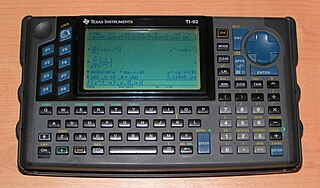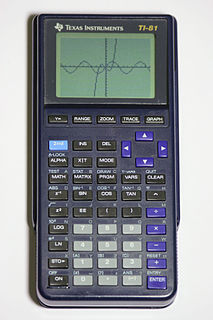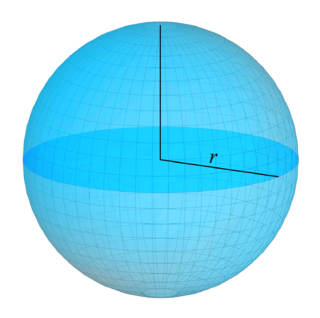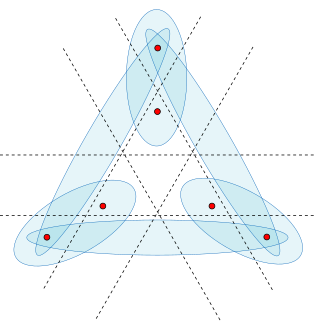Parametric statistics is a branch of statistics which assumes that sample data comes from a population that follows a probability distribution based on a fixed set of parameters. Most well-known elementary statistical methods are parametric. Conversely a non-parametric model differs precisely in that the parameter set is not fixed and can increase, or even decrease if new relevant information is collected.
Nonparametric statistics is the branch of statistics that is not based solely on parametrized families of probability distributions. Nonparametric statistics is based on either being distribution-free or having a specified distribution but with the distribution's parameters unspecified. Nonparametric statistics includes both descriptive statistics and statistical inference.

The TI-92 series of graphing calculators are a line of calculators produced by Texas Instruments. They include: the TI-92 (1995), the TI-92 Plus, and the Voyage 200 (2002). The design of these relatively large calculators includes a QWERTY keyboard. Because of this keyboard, it was given the status of a "computer" rather than "calculator" by American testing facilities and cannot be used on tests such as the SAT or AP Exams while the similar TI-89 can be.

In differential calculus, an inflection point, point of inflection, flex, or inflection is a point on a continuously differentiable plane curve at which the curve crosses its tangent, that is, the curve changes from being concave to convex, or vice versa.

In mathematics, a parametric equation defines a group of quantities as functions of one or more independent variables called parameters. Parametric equations are commonly used to express the coordinates of the points that make up a geometric object such as a curve or surface, in which case the equations are collectively called a parametric representation or parameterization of the object.

The TI-81 is the first graphing calculator made by Texas Instruments. It was designed in 1990 for use in algebra and precalculus courses. Since its original release, it has been superseded several times by newer calculators: the TI-85, TI-82, TI-83, TI-86, TI-83 Plus, TI-83 Plus Silver Edition, TI-84 Plus, TI-84 Plus Silver Edition, and most recently the TI-Nspire and TI-Nspire CAS. Most of these share the original feature set and 96×64-pixel display that began with this calculator.
Functional Design is a paradigm used to simplify the design of hardware and software devices such as computer software and increasingly, 3D models. A functional design assures that each modular part of a device has only one responsibility and performs that responsibility with the minimum of side effects on other parts. Functionally designed modules tend to have low coupling.
Continuity or continuous may refer to:
Predictive modelling uses statistics to predict outcomes. Most often the event one wants to predict is in the future, but predictive modelling can be applied to any type of unknown event, regardless of when it occurred. For example, predictive models are often used to detect crimes and identify suspects, after the crime has taken place.
A parametric surface is a surface in the Euclidean space
which is defined by a parametric equation with two parameters
Parametric representation is a very general way to specify a surface, as well as implicit representation. Surfaces that occur in two of the main theorems of vector calculus, Stokes' theorem and the divergence theorem, are frequently given in a parametric form. The curvature and arc length of curves on the surface, surface area, differential geometric invariants such as the first and second fundamental forms, Gaussian, mean, and principal curvatures can all be computed from a given parametrization.

MedCalc is a statistical software package designed for the biomedical sciences. It has an integrated spreadsheet for data input and can import files in several formats.

In mathematics, a surface is a generalization of a plane which needs not be flat – that is, the curvature is not necessarily zero. This is analogous to a curve generalizing a straight line.
There are several more precise definitions, depending on the context and the mathematical tools that are used for the study.

In discrete geometry, a k-set of a finite point set S in the Euclidean plane is a subset of k elements of S that can be strictly separated from the remaining points by a line. More generally, in Euclidean space of higher dimensions, a k-set of a finite point set is a subset of k elements that can be separated from the remaining points by a hyperplane. In particular, when k = n/2, the line or hyperplane that separates a k-set from the rest of S is a halving line or halving plane.
In descriptive statistics, the seven-number summary is a collection of seven summary statistics, and is an extension of the five-number summary. There are two similar, common forms.
Graphmatica is a graphing program created by Keith Hertzer, a graduate of the University of California, Berkeley. It runs on Microsoft Windows, Mac OS X 10.5 and higher, and iOS 5.0 and higher.
The survival function is a function that gives the probability that a patient, device, or other object of interest will survive beyond any given specified time.

Equalization or equalisation is the process of adjusting the balance between frequency components within an electronic signal. The most well known use of equalization is in sound recording and reproduction but there are many other applications in electronics and telecommunications. The circuit or equipment used to achieve equalization is called an equalizer. These devices strengthen (boost) or weaken (cut) the energy of specific frequency bands or "frequency ranges".
Parametric design is a process based on algorithmic thinking that enables the expression of parameters and rules that, together, define, encode and clarify the relationship between design intent and design response.








